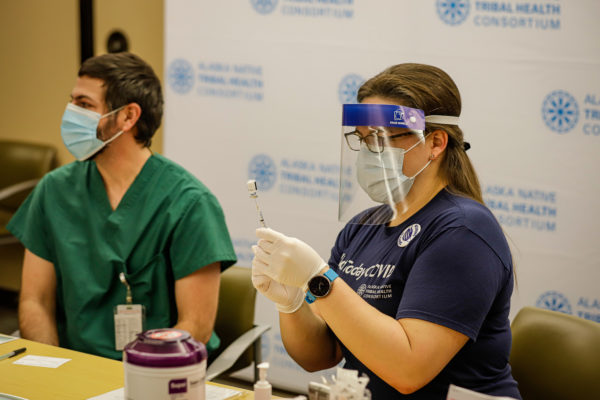
State health officials said some 26,800 doses of a second new COVID-19 vaccine arrived in Alaska on Monday.
On Friday, the Food and Drug Administration granted emergency use authorization to Moderna for the vaccine, which can be used on people 18 and up. State health officials said it’s being distributed this week in Alaska.
The Moderna vaccine has at least one big advantage over the Pfizer vaccine that started rolling out in Alaska last week. To prevent spoiling Pfizer’s must be held at extremely cold temperatures that regular freezers can’t reach. Once thawed, Pfizer’s vaccine can only be kept at refrigerator temperatures for a few days. Ketchikan, for example, found their first vaccine shipment was unusable.
Moderna’s vaccine is stable at minus 4 degrees Fahrenheit. It can be kept in refrigerators for up to 30 days.
“The Moderna vaccine will help us reach more communities, especially those that have less access to cold storage,” Tessa Walker Linderman, one of the heads of Alaska’s COVID-19 Vaccine Task Force, said in a press release. “Having both vaccines provides us more vaccine and more flexibility.”
Otherwise, the two vaccines share many characteristics. Both require two doses. The second dose of Moderna’s vaccine is supposed to be given four weeks after the first. Pfizer and Moderna’s vaccines are not interchangeable.
Two more potential COVID-19 vaccines, developed by AstraZeneca and Janssen, are in clinical trials.
In Moderna’s clinical trial, common reactions included fatigue, muscle pain or soreness, headache, chills, and fever. Out of the 15,000 plus people who got the vaccine in the trial, no one had a severe allergic reaction — anaphylaxis. More details about Moderna’s vaccine and results from its clinical trial are available in an FDA briefing.
Anaphylaxis is a rare reaction, but can be caused many common injections. It’s a life-threatening condition, but one that first responders and doctors can readily treat.
State health officials know of 11 possible allergic reactions to the Pfizer vaccine in Alaska: eight at Bartlett Regional Hospital in Juneau, two at Providence Alaska Medical Center in Anchorage and one at Fairbanks Memorial Hospital. Two were considered anaphylaxis.
The reactions were flagged during the observation period after injection. The state said all of the patients’ symptoms went away and they’re doing well.
State health officials said that at least 5,674 doses of the Pfizer vaccine had been administered in the state as of Sunday.
The supply of both vaccines is limited. Frontline hospital workers and long-term care facility residents and staff are at the front of the line, followed by EMS personnel and health care professionals more generally. A state committee of mostly health care professionals is fine tuning advice from the Centers for Disease Control and Prevention about who should be vaccinated when in Alaska.
Jeremy Hsieh is the deputy managing editor of the KTOO newsroom in Juneau. He’s a podcast fiend who’s worked in journalism since high school as a reporter, editor and television producer. He ran Gavel Alaska for 360 North from 2011 to 2016, and is big on experimenting with novel tools and mediums (including the occasional animated gif) to tell stories and demystify the news. Jeremy’s an East Coast transplant who moved to Juneau in 2008.





